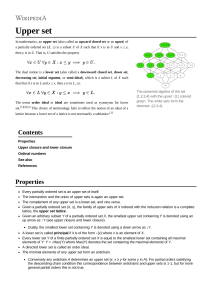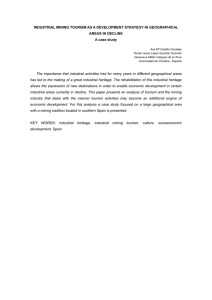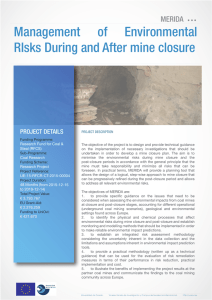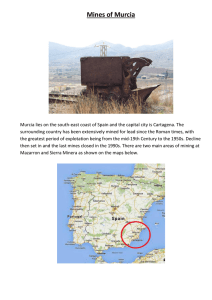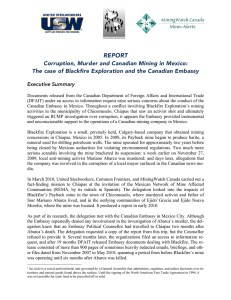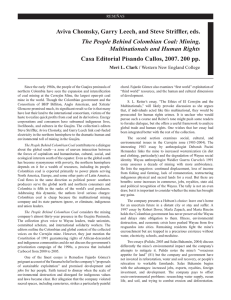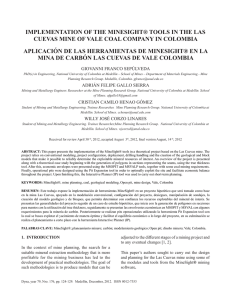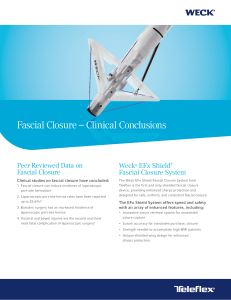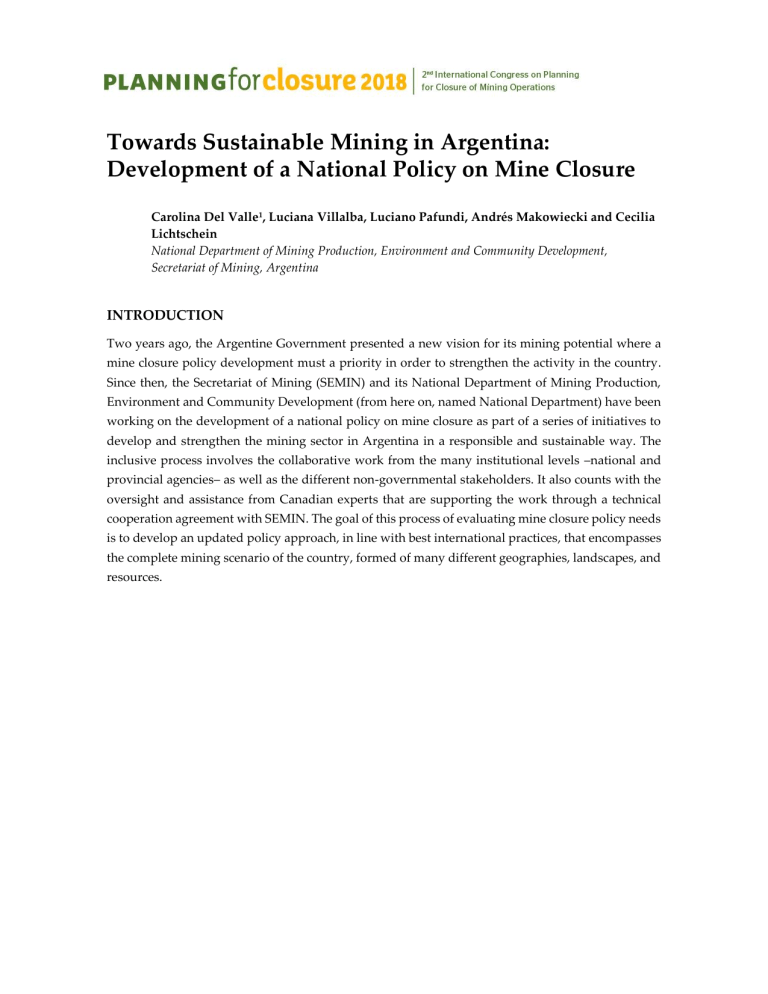
Towards Sustainable Mining in Argentina: Development of a National Policy on Mine Closure Carolina Del Valle1, Luciana Villalba, Luciano Pafundi, Andrés Makowiecki and Cecilia Lichtschein National Department of Mining Production, Environment and Community Development, Secretariat of Mining, Argentina INTRODUCTION Two years ago, the Argentine Government presented a new vision for its mining potential where a mine closure policy development must a priority in order to strengthen the activity in the country. Since then, the Secretariat of Mining (SEMIN) and its National Department of Mining Production, Environment and Community Development (from here on, named National Department) have been working on the development of a national policy on mine closure as part of a series of initiatives to develop and strengthen the mining sector in Argentina in a responsible and sustainable way. The inclusive process involves the collaborative work from the many institutional levels –national and provincial agencies– as well as the different non-governmental stakeholders. It also counts with the oversight and assistance from Canadian experts that are supporting the work through a technical cooperation agreement with SEMIN. The goal of this process of evaluating mine closure policy needs is to develop an updated policy approach, in line with best international practices, that encompasses the complete mining scenario of the country, formed of many different geographies, landscapes, and resources. METHODOLOGY Argentina adopted a new paradigm of mining by the year 2016, highlighting the need for accounting the social, economic and environmental factors within the industry. That was presented with the new structure of the Secretariat and the creation of the National Department. In line with the view of responsible and sustainable mining, a new version of the Federal Mining Agreement was proposed for discussion with the provincial authorities that are part of COFEMIN – the Argentine Federal Mining Council – as a way to establish a coherent policy regarding mining activity throughout the federal state. The content was subject to debate until it reached consensus and was signed by the provinces in June 2017. The first ‘Federal Mining Agreement'(1) dated back to 1993, and through the new document, the provinces agreed upon important subjects such as social and community aspects, mining environmental management, economic and tributaries aspects, and legal and institutional matters. The agreement serves as the basis for consensus and collaboration within the provinces, representing the political decision that supports the proposal of a new national policy for mine closure, among several other work initiatives aligned with social and environmental best practices, local development, transparency, and sustainability. Following this political decision and the perspective that is necessary to account for the entire mine cycle and predict actions on crucial stages of closure and post-closure, allowing more certainty to potentiate the activity, the National Department began working on a methodology to achieve an inclusive, transparent and credible process. Along the process of work collaborating with the provinces, the National Department identified it should consider the specific context and these important considerations: • • • • • • • Currently, the legal framework for mine closure in Argentina presents gaps that must be resolved. The Mining Code (2), a national law applied to all 23 provinces, presents a brief mention thanks to the sanction of Law 24.585, which incorporated into the Code the Title XIII “Environmental protection for the activity”. This title establishes the conditions that must be considered for the activities of "prospection, exploration, exploitation, development, preparation, extraction, and storage of minerals included all activities destined for the mine closure." Since Argentina has a federal government system, the provinces have the authority of complementing the Mining Code. As of today, only one out of 23 provinces (Catamarca) has a provincial normative in place that regulates the mine closure procedure. Until this moment, it is not clear what type of regulation could be adopted, therefore flexibility is needed. A federal country must have a federal discussion on the subject. The necessity to include the many different provinces, and at the same time, homogeneity in order to favor the regulation implementation. Different types of mining, metal ores and non-metal ores, should be considered. The development of mine closure policy has to go beyond government stakeholders. It is necessary to work through the institutional, political, and technical consensus and among all sectors of mining companies, unions, academia, NGOs and civil society. A common shared knowledge base that transects all stakeholders is needed in order to have a productive and informed participation in the discussion. • • Learning from experienced countries is a good approach to promote best practices. SEMIN has been proactive even without a policy in place and collaborated with existing closure plans being developed such as Pirquitas (Jujuy province), Manatial Espejo (Santa Cruz province) and Bajo de la Alumbrera (Catamarca province). The entire process started with internal meetings that gathered representatives from the 23 Provinces for presentation and discussion of the initiative on a national mine closure policy pushed forward by SEMIN. During the end of 2016, SEMIN hosted two meetings where the provincial mining authorities along with the National Department team discussed several topics related to the technical, social, environmental and financial aspects of mine closure. Those meetings represented a starting point that created the space needed for debate on the subject. In search of collaboration, SEMIN initiated conversations with the Canada Embassy and CIRDI (Canadian International Resources Development Institute). As a result of these conversations, a memorandum of understanding (MOU) was signed, which allowed establishing a technical cooperation agreement between SEMIN and CIRDI. With the agreement set in place, the initiative of developing mine closure policy at the national level also receives international expertise support. The guidance of highly specialized professionals with a long trajectory of work in mining projects around the globe was crucial to strengthen the process, through the promotion of leading practices and standards adopted by the mining industry. Simultaneously, the National Department team has continued working on the development of the main document with general guidelines that would serve as the basis for a draft Mine Closure Act, a document intended for analysis and discussion among all provinces. Along the process, the goal is to generate consensus through inclusive participation, which will build a case for a successful regulation to pass National Congress moving ahead. Truly, a hard task when it comes to pushing national legislation concerning natural resources that are under provincial stewardship. The "Guidelines of a Mining Closure Regime" document is structured in six axes (general, institutional, technical, environmental, social and financial aspects) including a series of items for each one. Each aspect is structured in a) General guidelines; b) Considerations for regulation; c) Good practices applicable. As an example, the Environmental axe presents five components: 1) Environmental elements of the mine closure plan; 2) Risk assessment: 3) Evaluation of accumulative impacts; 4) Land use on post-mining; 5) Environmental aspects of post-closure. With great effort, the first activity involving CIRDI took place in April 2017, in Buenos Aires. The “First Workshop on Mine Closure – Mine closure initiative based on best international practices” brought together CIRDI team of experts for a three-day workshop, instructing a diverse audience composed of national and provincial authorities, technical provincial staff, representatives from NGOs, the academic sector, and the CAEM (Mining Association of Argentina). Through a comprehensive agenda, presentations included themes such as global mine closure policy, planning for closure, environmental impact assessment, and mine closure, physical and chemical aspects of closure, reclamation, and risk, financial assurance, relinquishment, community engagement, and participation. The activity was very productive and generated deep interest within the provinces. It also launched the partnership with CIRDI and presented the leadership SEMIN was determined to take on pushing forward the national policy for mine closure. The work went progressing along the year with the elaboration of the guidelines document, and a manual of best practices intended to help the provinces in the implementation of mine closure policies. The initiative with CIRDI resulted so fruitfully that in November 2017 a second workshop was scheduled. This time, the National Department organized – supported with funds offered by the Canadian Embassy – a two-day workshop with the object to expand the discussion on the social and community aspects associated with mine closure. The workshop also had presentations from provincial representatives showing their experience in activities with the communities; the CAEM presented initiatives of good practices promoted within the industry; the San Julian Development Agency (an NGO from Santa Cruz province) displayed the work they carry collaborating with the local communities and Córdoba province demonstrated a proposal for land reuse alternatives on post-closure. Additionally, the National Department team along with Dr. Stevens’ group accomplished to present the mine closure initiative in the context of a COFEMIN meeting organized in the province of Córdoba. In front of the provincial mining authorities, CIRDI presented the case for a mine closure policy and its relevance, based on the best practices and standards available worldwide. Many questions and comments emerged, making it clear how important was to have all provinces represented on the table discussing the critical aspects of mine closure. As a result, the initiative showed the provinces willing to work and collaborate in the same direction and much more confident about the national government's sustainable development vision and goals. That was demonstrated by the province of Catamarca interested in bringing in CIRDI and the National Department for a workshop in their province. Another round of the mine closure workshop that represented a success for the consolidation of the initiative took place last April in Catamarca. CIRDI conducted a one-week training that included discussion of topics such as the public management actions necessary for control and oversight, and practical exercises on estimating the costs of closure activities and financial guarantees. A field trip to "Bajo de la Alumbrera" mine – which is waiting for approval from the provincial authority in order to initiate closure – served as a practical case. RESULTS AND DISCUSSION As a result, from all the work, activities put forward, and debate generated, the National Department concluded the elaboration of the mine closure guidelines document now ready for review. This document served as well to originate the draft for the Mine Closure Act, presented to COFEMIN last March. The agenda of documents circulation began with an internal revision by SEMIN and SEGEMAR (Geological Services of Argentine) members. At this stage, the documents have been submitted to members of COFEMIN for their review and feedback. Next steps will be to share them with the interested parties within the Ministry of Environment and Sustainable Development, and other governmental agencies. At the present day, one important goal has been achieved. In the last week of August, the National Department managed to host a 2-day work meeting putting together the provincial technical staff to discuss the proposed Mine Closure Act draft. During the two days, the participants worked side-byside bringing their experience and sharing the view of each province and their constraints regarding the applicability of this proposed national regulation. Some critical points that were deeply discussed and are clearly dependent on the particularities of each province are: • Criteria used for mining projects classification/ categorization • Mine closure requirements (depending on the project classification) • Engagement of (informal and formal) small-scale mining • Inclusion (or not) of exploration stage • The scope of the post-closure stage • Alternatives for post-closure land use • The scope of community participation on mine closure plans • Responsibilities of social risks and impacts management • Financial assurance for closure. Which option fits best the economic context of Argentina, and can respond to the province’s concerns? Types of financial guarantees; how it should be constituted, which mechanisms, upfront costs, etc. CONCLUSIONS The input from the many stakeholders – especially the provinces – will be crucial for the success of this project. So far, the ongoing process has generated a rich exchange of political and technical opinions. In part, the success of the project depends on the actual engagement and participation process. The National Department is seeking a broad consensus on the principal aspects to be legislated as a short-term result before the project faces formal discussion at the National Congress. At this point, the National Department intends to complete a best-practices guide on mine closure to support the provinces in their task of evaluating mine closure plans. Meanwhile, more work, debate, and training with the provinces will be needed to enhance the capacity to face critical subjects such as financial guarantees and responsibilities. REFERENCES Acuerdo Federal Minero (Ley N° 24.228). Sancionada: Julio 7 de 1993. Promulgada: Julio 26 de 1993. Available at: http://servicios.infoleg.gob.ar/infolegInternet/anexos/0-4999/624/norma.htm Código de Minería de la Nación (Ley N°1.919). http://servicios.infoleg.gob.ar/infolegInternet/anexos/40000-44999/43797/texact.htm Available at:
